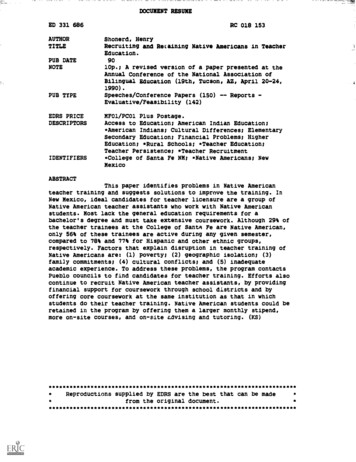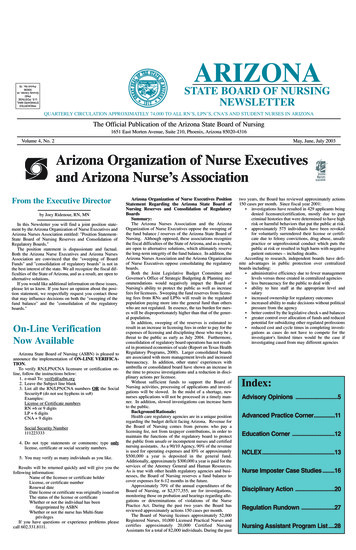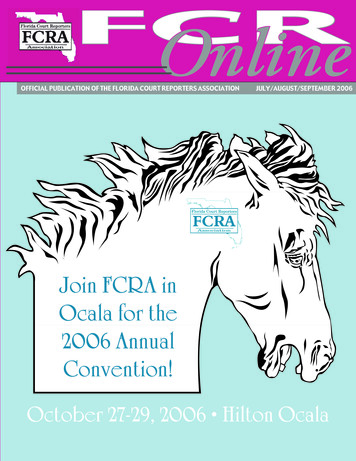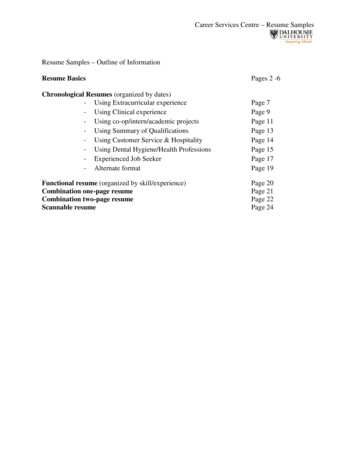
Transcription
DOCUMENT RESUMEED 331 686AUTHORTITLEPUB DATENOTERC 018 153Shonerd, HenryRecruiting and Retaining Native Americans in TeacherEducation.9010p.; A revised version of a paper presented at theAnnual Conference of the National Association ofBilingua1 Education (19th, Tucson, AZ, April 20-24,1990).PUB TYPESpeeches/Conference Papers (150) -- Reports Evaluative/Feasibility (142)EDRS PRICEDESCRIPTORSMF01/PC01 Plus Postage.Access to Education; American Indian Education;*American Indians; Cultural Differences; ElementarySecondary Education; Financial Problems; HigherEducation; *Rural Schools; *Teacher Education;Teacher Persistence; *Teacher Recruitment*College of Santa Fe NM; *Native Americans; NewMexicoIDENTIFIERSABSTRACTThis paper identifies problems in Native Americanteacher training and suggests solutions to improve the training. InNew Mexico, ideal candidates for teacher licensure are a group ofNative American teacher assistants who work with Native Americanstudents. Most lack the general education requirements for abachelor's degree and must take extensive coursework. Although 29% ofthe teacher trainees at the College of Sante Fe are Native American,only 56% of these trainees are active during any given semester,compared to 78% and 77% for Hispanic and other ethnic groups,respectively. Factors that explain disruption in teacher training ofNative Americans are: (1) poverty; (2) geographic isolation; (3)family commitments; (4) cultural conflicts; and (5) inadequateacademic experience. To address these problems, the program contactsPueblo councils to find candidates for teacher training. Efforts alsocontinue to recruit Native American teacher assistants, by providingfinancial support for coursework through school districts and byoffering core coursework at the same institution as that in whichstudents do their teacher training. Native American students could beretained in the program by offering them a larger monthly stipend,more on-site courses, and on-site advising and tutoring. *************************Reproductions supplied by EDRS are the best that can be madefrom the original ******************************
Recruiting and RetainingNative Americansin Teacher EducationCPZHenry ShonerdCollege of Santa Feett(This paper is a revised and expanded version of apresentation for the 19th Annual Conference of the NationalAssociation of Bilingual Education in Tucson, Arizona onApril 24, 1990.)IntroductionAn important strategy in the education of language minoritychildren is the employment of language minority teachers.This requires a focus on the teacher certification process.This paper presents an overview of the Native Americancomponent of a federally-funded teacher training program.(The observations expressed here are those of the directorof the program, also its primary recruiter.) The programserves a section of the Rio Grande basin in Central NewMexico, an area with relatively large numbers of NativeAmericans, particularly Pueblos and Navajos. Much of thecoursework and all of the practicums and student teachingare done on-site in rural schools with high proportions ofNative American children. The program pays the tuition,fees, and books of the all the teacher trainees; some oftheir transportation costs; and a small stipend tifull-time trainees.This paper concentrates on problematic aspects of NativeAmerican teacher training and suggested solutions. Thisdoes not mean there have been no successes. Rather, theintention is to point out difficulties encountered byNative Americana during teacher training which aredifferent in either degree or kind from those encounteredby other ethnic groups. These difficulties are a hindrancefor Native Americans to enter into and complete degree,licensure and endorsement programs.051E4Also, in thinking about Native Americans, it is importantto keep in mind the differences among these varied peoples.In particular, Navajos and Pueblos constitute populationswith very different linguistic, geographic and historicalbackgrounds. Such differences which impinge on recruitmentand retention in teacher training will be explored.-PERMISSION TO REPRODUCE THISMATERIAL hiAS EE GRANTED BYODU.S. DEPARTMENT OF EDUCATIONMill Otto at EdwabOrdi ddo and ImirennwieltEDUCATIONAL RESOURCES INFORMATIONCENTER IERICIZ.' This etocumoot Ino boon roolodurott asocopsoo horn too mow of ocEllommton40001mAn0 II,.REST COPY AVAILABLEMoto. cosmos Novo Non two to moraystemauctIon gummyPosnts 01 yore Ot OPHoOn 1000 in t0000cirmoat dO not oCOMIlvOERI ocealion et DowMOWN OffiCal2TO THE EDUCATIONAL RESOURCEEINFORMATION CENTER (ERIC)."
RecruitingEven though Native Americans represent a higher percentageof the population in NM than they do in any other state,their numbers are still small relative to the rest of thepopulation. They constitute only about 5% of the populationwithin the area served by the teacher training programreported on here.On the other hand, in each of approximately a dozen schoolsin this area, there is a group of Native American teacherassistants working with Native American students. Theseteacher assistants are ideal candidates for teacherlicensure (elementary and secondary), since they have aproven commitment to education and valuable classroomexperience working with Native American children.Unfortunately, most do not meet eligibility requirementsfor entry into the licensure program: 1) completion of thelower division "core" (a.k.a., general education) courseswhich include science, math, social sciences, writing andliterature; and 2) a passing score on a standardized testof general knowledge and communication skills. Native American teacher assistants contacted as candidatesfor recruitment into this program are usually far fromhaving completed the general education requirements for abachelor's degree. This is true despite the fact thet manyhave completed large amounts of college or universitycredit. Most of their courses are through departments ofcurriculum and instruction, that is courses in teachingmethods, and get them no closer to completing the lowerdivision core (math, science, writing, etc.) needed forentering a licensure program.This is not meant to deny the value of the coursework thatis generally offered and taken. The coursework is providedon-site in rural areas where many of these Native Americanteaching assistants are serving Native American children.By making such coursework available, the colleges and anduniversities provide an undeniable service, and takingfinishing such coursework constitutes a real accomplishmentfor the students.However, while the teaching methods coursework is helpfulto teachirg assistants in their work as teacher assistants,it can not alone lead to a bachelor's degrees. Effectively,by takiag only methods courses, the teaching assistants arelocked into a vocational track.Of course, it may be argued that this teaching methodscourses make the paraprofessionals more effective in theclassroom. But the same argument could be made of corecourses in math, science, writing, etc., perhaps more so.23
Moreover, satisfactory completion of these core courses isessential to success on standardized tests.In New Mexico, candidates for licensure must takestandardized tests of general knowledge and communicationskills. National statistics show that minorities of allkinds, Native Americans included, make a poor showing onsuch tests. The results of the standardized test screeningof minorities in our program bears this out: NativeAmericans are the most likely of the ethnic groups in ourprogram to fail this testing.These problems are rooted in the educational system forNative Americans K-12. The New Mexico Indian Education TaskForce in proposing a framework for restructuring IndianEducation in 1988 said:A clear consensus of agreement emerged reflecting thescholastic problems of Indian students including lowtest scores, high dropout rates, frequent absenteeism,high sucicide rates and poor performance at advancedstudies.This scenario both explains the lack of Native Americanseligible for teacher training and argues most eloquentlyfor the training of highly qualified Native Americans forthe education of Native American children.Recent years have seen notable increases in Native Americanelementary teachers. The number of Native Americansecondary teachers remains very low. It.is thereforeunfortunate that practically none of the qualified NativeAmericans candidates for our program seek secondarylicensure. Those Native Americans that have entered ourprogram only for endorsement in bilingual education (thosealready possessing licensure) have all been elementaryteachers. This upgrade of Native American elementaryteachers does not confront the lack of Native Americans inthe secondary "content" areas. The strongest NativeAmerican candidates for secondary licensure have been thosewith BA's in content areas (e.g., business administration)before entering our program.In addition to academic factors outlined above, otherfactors militate against the recruitment of NativeAmericans into teacher training. Economic, geographic,social and cultural factors discussed below that influenceretention also have a negative impact on recruitment. Yet astrong recruiting effort among Native Americans has bornfruit. In a program that has openings for about fifty-fivetrainees at any given time, the average number andpercentage of those trainees by ethnicity over foursemesters in 1989 and 1990 was the following:4
Table 1Number and Percentage of Traineesin Program By EthnicityEthnicityof TraineesNumberof TraineesPercentageof Trainees1629%48%23%Native AmericanHispanicOther2713Note: "Other" consists of African-American and Anglotrainees.Retaining (and Graduating) Native AmericansThe fact that one is admitted to a teacher training programdoes not mean the battle is over. Far from it. Teachertraining is an arduous process which requires much of thetrainee. Native Americans in our program have beenespecially prone to interruptions in the process leading tolicensure. The following data strongly suggest that suchinterruptions are associated with permanent withdrawl of anunacceptably high proportion of Native Americans from theprogram.Table 2Academic Status of Teacher TraineesOver Four Semesters Spring '89 - Sum '90(Percentages)Academic StatusActiveInactiveAvailableEthnicityNativeAmer (N 16)No CoursesDropped fromProgram56%6%26%12%(N 27)78%11%7%4%Other (N 13)77%15%8%0%HispanicWhat These Percentages Tell UsThe first column indicates what percentage of the traineesin the three ethnic groups (in a given semester) madeprogress toward licensure (elementary or secondary) and/or
endorsement (bilingual and ESL), the second column whatpercentage could make no progress toward licensure and/orendorsement because none of the required courses wereavailable to them during a given semester, the third columnthe percentage that decided against taking courses (eventhough courses were available), and the fourth column whatpercentage dropped from the program.What we see in this table is that in any given semesterNative American trainees are more prone to temporary orpermanent disruptions in the teacher training process. Asthe second column indicates, required coursework is morelikely to be available to the Native American trainees thanto the other ethnic groups. Yet, other kinds of disruptions(third and fourth columns) occur among Native Americans ata rate more than three times that of other ethnic groups inthe program. More than one-fourth (26%) of the NativeAmericans in a given semester choose to nut take courseseven though courses are available; almost one-eighth (12%)drop from the program each semester.Factors Which Explain Disruptions in Teacher Training ofNative AmericansWhy should the Native American trainees experience so muchmore disruption in the teacher education process? Here aresome possible contributing factors.1. Poverty - Though our program subsidizes the direct costsof the teacher training (tuition, books and fees),incidental costs such as baby-sitting and transportationare not covered except for full-time students. Though parttime students from other ethnicities are in much the sameposition, their situation is probably on the average lessprecarious. Unemployment rates among Native Americans areso high so that those with jobs (e.g., teacher assistants)are depended upon by their families even more than amongother ethnic groups. Even relatively modest incidentalcosts due to teacher training may prove unbearable. Underthe circumstances, dropping a full-time job as teacherassistant (even to a part-time status) to make more timefor studying is often unthinkable, even though ultimatelyit would mean better pay. Permanent economic hardshipbrings with it very high rates of poor health,dysfunctional family relations, alcoholism and suicide.Such conditions make education very difficult.2. Geographical Isolation - Most Native American traineeslive in rural settings at some distance from where classesare held. This problem is especially pronounced for Navajosin our program who come to class from as many as 100 milesaway. This travel creates not only economic costs butphysical and emotional hardship as well.
3. Family Commitments - The majority of Native Americantrainees are women (having more to do with gender ineducation, in particular elementary education, than withethnicity). Many are mothers, often single mothers. As withtransportation, paid child care is usually unaffordable."Free" child care by older siblinAl or others within theimmediate or extended family is part of a complex ofobligations that will as often conflict with regular courseattendance as it does promote it.4. Cultural Conflicts - The relations of dominant to NativeAmerican cultures have been repressive. Culturalrepression and economic marginalization have gone hand inhand. The Pueblos and Navajoe served by the program havebeen some of the most successful among all Native Americansin maintaining their linguistic and cultural identity inthe face of this repression. Not surprisingly, thissometimes puts the goals of a mainstream educationalprogram (such as ours) into conflict with tribalobligations associated with maintaining tribal affiliationand identity. For example, the traditional rituals of thePueblos (of agriculture and the hunt) may take place duringclass time.5. Academic Experience - Culture influences not only timeframes, but frames of mind as well. Our literacy-based,teacher-centered classrooms depart radically from thetraditional learning contexts of the Pueblos and Navajos.This undoubtedly helps determine the differential successrate of Native Americanu and other cultural groups in ourprogram. Many of the Native American trainees in theprogram are first generation college students. This factinfluences subtly, but profoundly, the academicexpectations that these students have for themselves andthat their teachers have of them. This affects the qualityof their education all through school but especially in thesecondary grades, and consequently their chances of successonce they arrive in college.These circumstances act as roadblocks to the progress ofthe Native American trainees in our teacher educationprogram. This would not be so bad if the roadblockspresented no more than temporary detours. If NativeAmericans eventually graduated, the difficulties wouldperhaps be acceptable. Unfortunately, very low graeuationrates of Native Amaricans as compared to other ethnicgroups in the program indicate that the obstacles knock outall but a few of those who stF.rt the training. Thefollowing table shows gradusion rates of trainees over thecourse of four semesters (Spring '89 - Summer '90).
Table 3Graduation Rates of Teacher TraineesNum inProgram% inProgramNumberGradsGraduationRateNat Amer1629425Hispanic27481556Other13231292For all practical purposls, the graduation rate is thesurvival rate, and a survival rate of only 25% isunacceptable. What then can be done to raise the odds ofsurvival of Native Amerlcans in our teacher trainingprogram?Possible SolutionsRecruitmentThis component of our program is slowly becoming morecommunity-based and longer range in its approach. Untilrecently, all recruiting was done in the schools wherethere are Native American teacher assistants. Lately,contacts have been made among Pueblo councils in an effortto find new candidates for the program and to encouragecommunity support of those already in the program. Also,instead of focussing the recruiting effort only on findingthose who are already eligible for the program, regularcontacts are maintained with promising Native Americancandidates still short of requisite coursework to encouragetheir steady progress toward eligibily.One method of recruitment now under consideration is toprovide a steady flow of eligible Native Americans into theteacher training program through a "feeder" program ofNative American teacher assistants. Such an approach wouldhave the teacher assistants take their core coursework(lower division coursework required for entrance to teachereducation program) at the same institution where they willbe doing their teacher training. This will promote theclosest possible contact between promising candidates andthose directing the teacher training program. Under theproposal, school districts where the teacher assistants areemployed would pay for their coursework out of federal andstate funds. This would allow the kind of collaboration oflocal educational agencies and institutions of highereducation now being promoted by OBEMLA (the Office ofBilingual Education and Minority Languages Affairs).7
Retention1. More Money - Some of the problems are simply economic.Larger stipends (currently 175/month), more funds forcosts of student transportation, and funds for child careare straightforward responses to the most common financialburdens of the training process. The amount of moneyavailable for these items in our budget has beeninadequate. Putting additional money into unavoidableindirect costs of teacher education is necessary to makethe expenditure of funds on tuition, fees and books moreefficacious.2. More On-site Courses - Rather than bring students to theteacher, the teacher could go to the students. Thissolution is only possible, however, if there ate enoughstudents for the classes to "make". The Native Americantrainees are usually widely spread in sparsely populatedareas. Though quite a few satellite courses have been madeavailable until now, the possibilities have been limited bynot pooling resources and trainees in a systematic fashion.3. On-site Advising and Tutoring - Until now, counselingand tutoring have not been available at the satellitecampus where teacher education classes for the program aretaught nor at rural sites where many of the Native Americantrainees live and work. Under a cooperative arrangement tobegin soon, a team of specialists (from the main campus) indevelopmental reading, writing and math will maiv, regularvisits to these locations. They will monitor and promotethe coursework of Native Americans in both the feeder andteacher education classes. They will also provide trainingsessions for the entrance tests to the teacher educationprogram.ConclusionSome of the solutions to recruitment and retention ofNative Americans in any teacher education program lieoutside the program itself. The underlying problems forNative Americans in this teacher training program arebroadly based. Until far-reaching issues of educational,economic, social and cultural equity for Native Americansare addressed, the search for local solutions to the issueof teacher training will be frustrating. Yet localeducation programs (like ours) by and for Native Americanswill continue to be both a litmus and engine of overallprogress.Despite their disenchantment with the educational processesof mainstream society, practically all Native Americans Iknow believe that some form of institutionalized schoolingis essential for their individual and collective survival.8
Most feel that Native American control of that educationalprocess through teaching by Native American teachers isessential. Federal support of Native American teachertraining programs encourages this input. Hopefully, thispaper has provided practical ideas on how to increase theeffectiveness of funding for these programs.910
*College of Santa Fe NM; *Native Americans; New Mexico. ABSTRACT. This paper identifies problems in Native American teacher training and suggests solutions to improve the training. In New Mexico, ideal candidates for teacher licensure are a group of Native American teacher assistants who work with Native American students.











